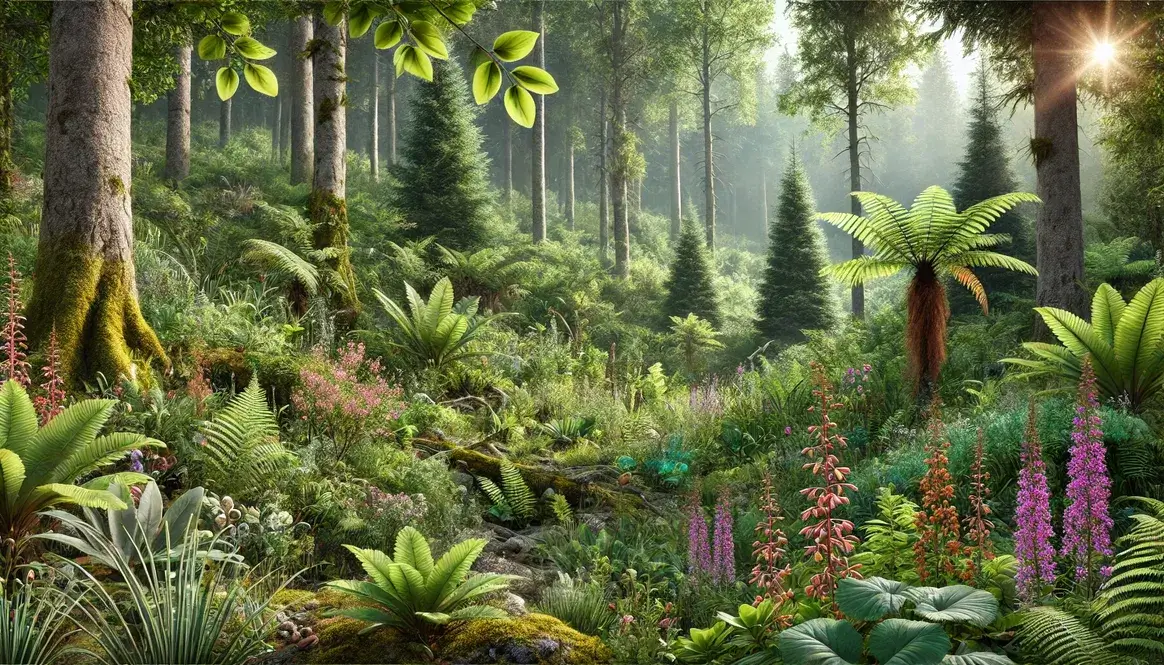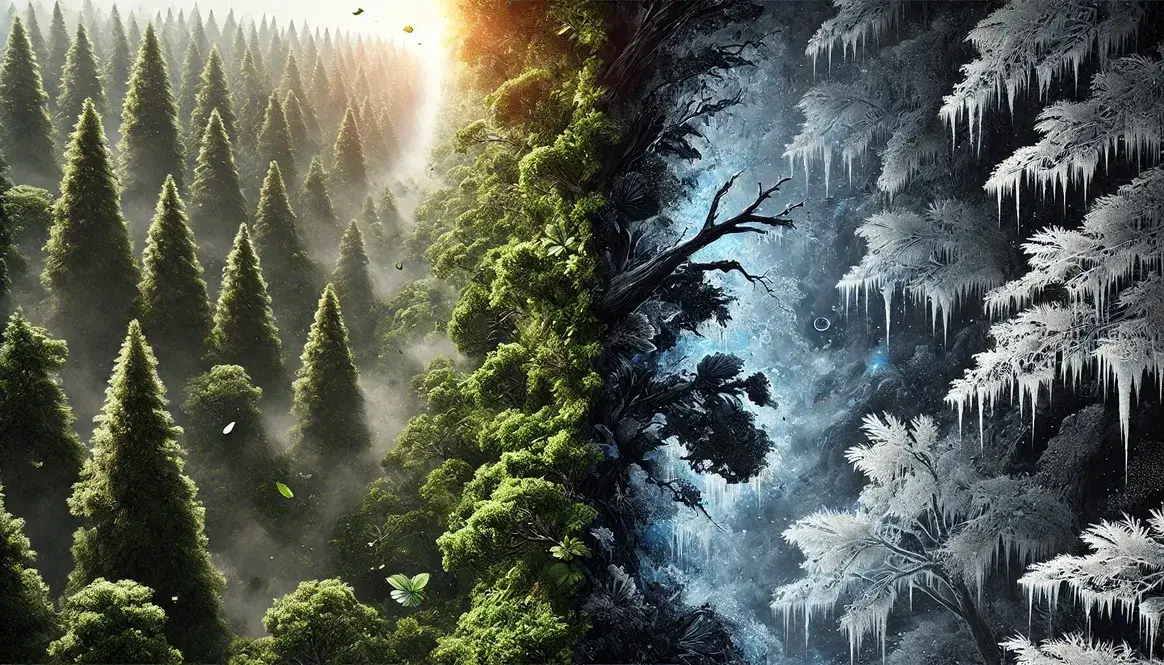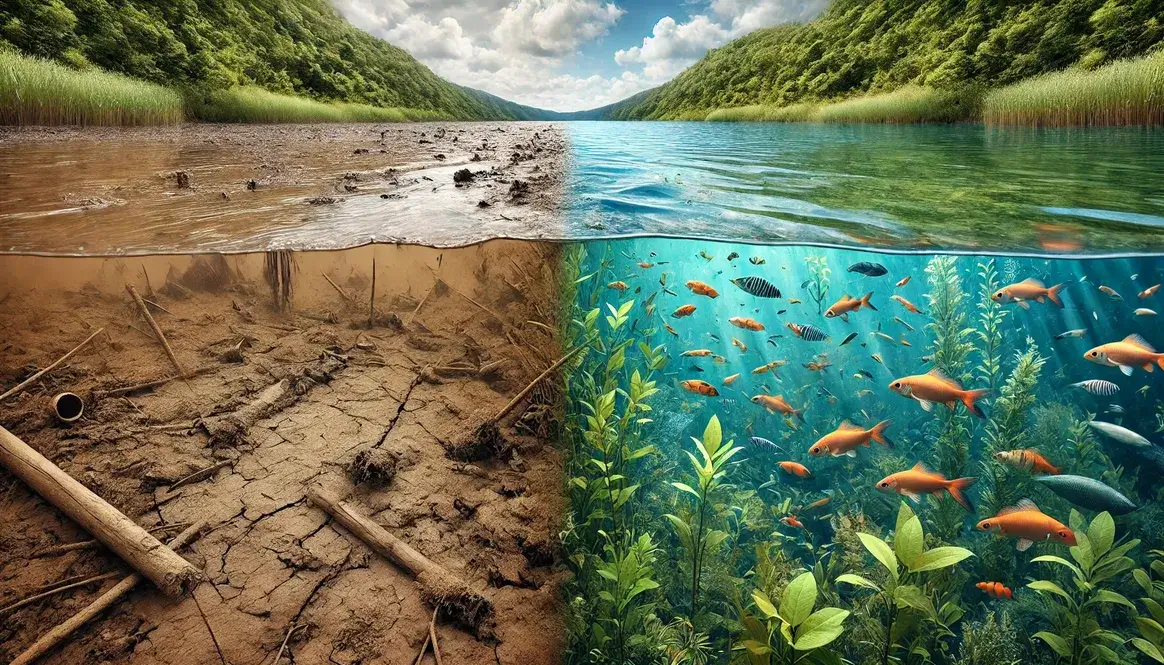Plants during the Cretaceous period faced significant climate changes and adapted in remarkable ways. These adaptations allowed them to thrive and set the stage for the plant world we see today.
| Key Adaptations | Climate Challenges |
|---|---|
| Larger leaves | Rising temperatures |
| Increased water efficiency | Higher CO2 levels |
| New reproductive strategies | Changing rainfall patterns |
| Enhanced photosynthesis | Seasonal variations |
The Cretaceous period, spanning from 145 to 66 million years ago, was a time of great change for Earth’s plant life. This era saw a warmer climate than today, with higher carbon dioxide levels and no polar ice caps. The plant world was dominated by gymnosperms like conifers and cycads, but a new group was about to make its mark.
During this time, the major plant groups included:
- Conifers: Tall, cone-bearing trees similar to modern pines and firs
- Cycads: Palm-like plants with stout trunks and large leaves
- Ferns: Ancient plants that thrived in the warm, humid climate
- Ginkgoes: Trees with fan-shaped leaves, ancestors of today’s ginkgo biloba
- Angiosperms: The newly emerging flowering plants
How Plants Adapted to Cretaceous Climate: Early Changes
As the Cretaceous climate shifted, plants had to adapt quickly to survive. These early changes laid the foundation for the diverse plant life we see today.
Adapting to Rising Temperatures
As temperatures increased, plants developed several strategies to cope:
- Larger leaves: Many plants grew bigger leaves to increase their surface area for cooling.
- Waxy coatings: Some plants developed waxy layers on their leaves to reduce water loss.
- Deeper roots: Plants grew longer roots to access water from deeper in the soil.
These adaptations helped plants manage the heat and maintain their water balance in the warming world.
Responding to Rising CO2 Levels
The Cretaceous period saw carbon dioxide levels in Cretaceous much higher than today. Plants adapted to this change in surprising ways:
- Enhanced photosynthesis: Plants became more efficient at using CO2 for photosynthesis.
- Reduced stomata: Some plants developed fewer stomata (tiny pores on leaves), as they could absorb more CO2 with less water loss.
- Faster growth: Higher CO2 levels allowed many plants to grow faster and larger.
Evolution of New Leaf Structures
Plants also adapted their leaf structures to the changing climate:
| Leaf Adaptation | Function |
|---|---|
| Thicker leaves | Better water retention |
| Needle-like leaves | Reduced water loss in dry areas |
| Broader leaves | Increased light capture in shady forests |
These leaf adaptations helped plants thrive in various Cretaceous environments, from lush forests to drier regions. As the period progressed, these early changes set the stage for even more dramatic plant innovations.
Mid-Cretaceous Plant Innovations
The middle of the Cretaceous period saw some of the most exciting changes in plant life. As the climate continued to shift, plants developed new and creative ways to thrive.
The Rise of Flowering Plants
Around 125 million years ago, a revolution began in the plant world. Flowering plants, also known as angiosperms, emerged and quickly spread across the planet. This rapid diversification was one of the most significant events in plant evolution.
Flowering plants had several advantages that helped them adapt to the Cretaceous period climate:
- Faster reproduction: Flowers allowed for quicker and more efficient reproduction.
- Fruit production: Fruits protected seeds and aided in their dispersal.
- Versatile structures: Flowers could adapt to attract different pollinators.
- Efficient water transport: Angiosperms developed better vascular systems.
These advantages allowed flowering plants to colonize new environments rapidly. They could adapt to changing conditions more quickly than their predecessors, giving them an edge in the ever-changing Cretaceous world.
New Strategies for Water Conservation
As parts of the planet became drier, plants had to find new ways to conserve water. They developed several drought-resistant features:
- Smaller leaves: Some plants reduced leaf size to minimize water loss.
- Thick, waxy cuticles: These coatings on leaves helped prevent evaporation.
- Sunken stomata: Placing stomata in small pits protected them from wind and reduced water loss.
Changes in root systems were also crucial for water conservation:
| Root Adaptation | Function |
|---|---|
| Deeper roots | Access water from far below the surface |
| Wider spreading roots | Collect water from a larger area |
| Root hairs | Increase surface area for water absorption |
Some plants even developed specialized water storage tissues. These adaptations allowed plants to survive in areas with less reliable rainfall, expanding their potential habitats.
The mid-Cretaceous innovations in plant biology set the stage for the diverse plant life we see today. As flowering plants spread and new water conservation strategies emerged, the stage was set for even more dramatic changes in the late Cretaceous period.
Late Cretaceous Plant Adaptations
As the Cretaceous period progressed, plants continued to evolve and adapt to the changing climate. The late Cretaceous saw some of the most remarkable plant adaptations, especially in response to extreme heat and the unique conditions of polar regions.
Coping with Extreme Heat
The late Cretaceous was a time of intense heat, and plants had to develop new strategies to survive. These adaptations were crucial for preventing water loss and maintaining efficient photosynthesis in high temperatures.
Plants developed several key adaptations to prevent water loss:
- Reduced leaf size: Smaller leaves meant less surface area for water to evaporate from.
- Leaf orientation: Some plants evolved leaves that could change their angle to avoid direct sunlight during the hottest parts of the day.
- Hairy leaves: Fine hairs on leaves created a boundary layer of still air, reducing water loss.
Changes in plant metabolism and photosynthesis were also vital:
- CAM photosynthesis: Some plants developed Crassulacean Acid Metabolism (CAM), allowing them to open their stomata at night when it’s cooler, reducing water loss.
- C4 photosynthesis: This more efficient form of photosynthesis helped plants cope with high temperatures and low water availability.
These adaptations allowed plants to thrive even in the hottest environments of the late Cretaceous.
Surviving in Polar Regions
While much of the Cretaceous was hot, the polar regions presented unique challenges. Plants in these areas had to adapt to long days in summer, long nights in winter, and generally cooler temperatures.
Plant adaptations to long days and seasonal changes included:
| Adaptation | Function |
|---|---|
| Deciduous habit | Shedding leaves to conserve energy during dark winters |
| Rapid growth cycles | Completing life cycles during short growing seasons |
| Light-sensitive pigments | Responding quickly to changing light conditions |
Dinosaurs in Arctic environments coexisted with these uniquely adapted plants, creating fascinating ecosystems at the poles.
Strategies for coping with cooler temperatures were also crucial:
- Antifreeze proteins: Some plants developed proteins that prevented ice crystal formation in their cells.
- Insulating structures: Thick bark and dense growth patterns helped protect against cold.
- Cold-resistant seeds: Seeds evolved to withstand freezing temperatures and germinate quickly when conditions were right.
These adaptations allowed plants to colonize polar regions, creating lush forests even at high latitudes during the Cretaceous period.
The late Cretaceous plant adaptations demonstrate the incredible resilience and adaptability of plant life. From scorching equatorial regions to the challenging polar environments, plants found ways to thrive, setting the stage for the diverse plant world we see today.
Plant-Climate Feedback Mechanisms
The relationship between plants and climate during the Cretaceous period was a two-way street. As plants adapted to the changing climate, they also played a crucial role in shaping it.
The Role of Plants in Cretaceous Climate Regulation
Plants had a significant impact on atmospheric CO2 levels during the Cretaceous. Through photosynthesis, they absorbed large amounts of CO2, helping to regulate the greenhouse effect. The spread of forests across the planet created vast carbon sinks, potentially moderating the warming trend.
However, the relationship was complex:
- Increased plant growth: Higher CO2 levels led to more plant growth, which in turn absorbed more CO2.
- Albedo effects: As vegetation spread, it changed the Earth’s reflectivity, affecting global temperatures.
- Water cycle changes: Plants influenced local and global water cycles through transpiration.
The impact of changing vegetation on local and global climates was profound. As new plant types spread, they altered ecosystems and climate patterns. For example, the rise of flowering plants may have influenced Cretaceous period weather by changing patterns of water vapor release into the atmosphere.
The Legacy of Cretaceous Plant Adaptations
The adaptations that plants developed during the Cretaceous period have had a lasting impact on the plant world we see today.
Many modern plant features can be traced back to Cretaceous innovations:
- Flowering plant diversity
- Efficient water-use strategies
- Adaptations to extreme environments
- Complex plant-pollinator relationships
These Cretaceous adaptations set the stage for the incredible plant diversity we see in modern ecosystems. From the rainforests to the deserts, many of the survival strategies used by plants today have their roots in Cretaceous adaptations.
The lessons we can learn from Cretaceous plants for understanding current climate change are valuable:
| Lesson | Application to Today |
|---|---|
| Plants can adapt rapidly | Gives hope for ecosystem resilience |
| Climate and plants are interlinked | Highlights importance of plant conservation |
| Extreme adaptations are possible | Suggests potential for future plant evolution |
Understanding how plants adapted to the dramatic climate changes of the Cretaceous can provide insights into how modern plants might respond to ongoing climate change. It underscores the importance of preserving plant diversity as a buffer against environmental changes.
As we face our own era of climate change, the story of Cretaceous plants reminds us of the resilience of life on Earth. It also highlights the crucial role that plants play in regulating our planet’s climate, a role that continues to this day.









